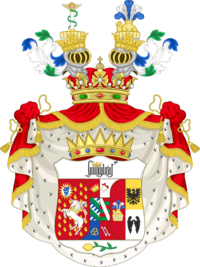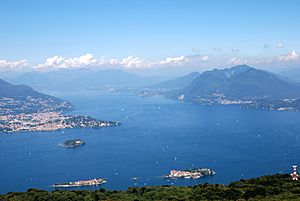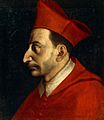House of Borromeo facts for kids
Quick facts for kids Borromeo |
|
|---|---|
| Noble family | |

|
|
| Country |
|
| Current region | |
| Place of origin | Rome |
| Founded | 1445 |
| Founder | Vitaliano I |
| Current head | Vitaliano XI |
| Titles |
|
| Style(s) | Don or Donna |
| Estate(s) | Rocca d'Angera Palazzo Borromeo, Milan Castel of Peschiera Borromeo Borromean Islands Villa Borromeo, Arcore |
| Deposition | 1797 |
| Cadet branches | Borromeo Arese |
The House of Borromeo is an old and important noble family from Italy. They started as merchants in a town called San Miniato around the year 1300. Later, they became very successful bankers in Milan after 1370.
A key member, Vitaliano de' Vitaliani, took the name Borromeo from his uncle. He became the Count of Arona in 1445. His family members played big roles in the government of the Duchy of Milan. They also became important cardinals in the Catholic Reformation, a time of big changes in the Catholic Church. In 1916, the head of the family was given the special title of Prince of Angera by the King of Italy.
Some of the most famous Borromeo family members were cardinals and archbishops of Milan. These include Carlo (1538–1584), who became a saint in 1610. Another was Federico (1564–1631), who started the famous Ambrosian Library in Milan. The unique symbol of the Borromean rings, which is on the family's coat of arms, is known in many different fields like math and religion.
Contents
Family History
Around 1300, many merchant families in San Miniato used the name "Buon Romei" or "Borromei." This name showed that their families originally came from the city of Rome.
The first family member to become well-known was Filippo. He was supported by the Holy Roman Emperor Charles IV and Gian Galeazzo Visconti, who later became the Duke of Milan. Filippo led a group called the Ghibellines in San Miniato. They revolted in 1367 against the Florentine Guelphs. In 1370, Filippo was captured by the Florentines and sadly, he was executed.
He had five children who had moved to Milan during the revolt. His sons, Borromeo and Giovanni, started the Borromei Bank in Milan. Other family members also ran banks in cities like Venice and Florence.
Filippo Buonromei married Talda di Tenda. Her sister, Beatrice di Tenda, was a famous figure in a tragic opera. Filippo's daughter, Margherita Borromeo, married Giacobino Vitaliani. Their son, Vitaliano Vitaliani (1390-1449), was adopted in 1406 by his uncle, Giovanni Borromeo. Giovanni owned the Milan bank and had no children of his own.
The Vitaliani family had a long history, going back to the 11th century. In 1418, Vitaliano I Borromeo became the treasurer for his uncle, Duke Filippo Maria. The Duke also made him the Count of Arona in 1446. Vitaliano bought the lands and castles of Arona and, in 1449, Angera on the shores of Lago Maggiore. The castle of Angera is still owned by the family today. Since then, the Borromeos have been the main landowners around Lago Maggiore.
Vitaliano Borromeo built a castle at Peschiera Borromeo near Milan in 1437. In 1450, Francesco I Sforza wanted to become the new Duke of Milan. The Borromeo family helped him, and he used their castle as a base to attack Milan. When Francesco became duke, he was very thankful. He gave the family many rewards and honors. One of these was the title of "Count of Peschiera" for Vitaliano's son, Filippo Borromeo (1419–1464), in 1461. Filippo made the family's bank even bigger, with branches in places like Bruges and London.
In 1520, Ludovico Borromeo built the Rocca Vitaliana castle at Castelli di Cannero. This was a fort to protect against attacks from the Old Swiss Confederacy. Giberto II Borromeo (who died in 1558) was a governor in the Lago Maggiore area. He married Margherita Medici di Marignano, who was the sister of Pope Pius IV. One of their sons, Carlo Borromeo (1538−1584), became a very important cardinal and archbishop of Milan. He was later made a saint.
The Borromeo family has owned the beautiful Borromean Islands since the 16th century. These islands have amazing gardens. Two of the islands have grand palaces, which the family still owns. Vitaliano Borromeo built a summer palace on Isola Bella for his wife Isabella between 1650 and 1671. This palace was later made even bigger by Cardinal Giberto III (1615–1672) and Count Vitaliano VI (1620–1690). Count Carlo IV (1657–1734) added the famous garden terraces. The family still owns most of the Borromean Islands today.
The Borromeo "State"
Between the 14th and 17th centuries, the Borromeo family gained control of many lands in the Valdossola and Lake Maggiore area. They organized these lands like an almost independent "state" within the Duchy of Milan. They had their own power, laws, and control over the local army and forts.
This "state" was divided into ten smaller areas called "podesterie." These included places like Mergozzo, Omegna, and Cannobio. The main judge for the Borromeo Counts was in Arona. This judge was independent from the courts in Novara and Milan, which used to control the area. The "state" was quite large, covering almost half of the modern Province of Verbano-Cusio-Ossola. It was about one thousand square kilometers in size.
The "Borromeo's State" ended in 1797. This happened when Napoleon Bonaparte invaded Milan. He took away all the special rights and powers the Borromeo family had over this area. So, the Borromeo family only kept their large estates, like the Borromean Islands, but no longer ruled them as a separate state.
Important Cardinals
Seven members of the Borromeo family became cardinals in the Roman Catholic Church:
- Carlo Borromeo (St. Carlo), born 1538, died 1584
- Federico Borromeo, born 1564, died 1631
- Giberto III Borromeo, born 1615, died 1672
- Federico Borromeo, born 1617, died 1673
- Giberto Bartolomeo Borromeo, born 1671, died 1740
- Vitaliano Borromeo, born 1720, died 1793
- Edoardo Borromeo, born 1822, died 1881
Family Titles
The Borromeo family has held several important titles over the centuries:
- Count of Arona: This title was given in 1446 to Vitaliano Vitaliani, who was adopted into the Borromeo family.
- Count of Peschiera: This title was given in 1461 to Filippo Borromeo.
- Marquess of Angera: This title was first given in 1623 by King Philip IV of Spain to Cardinal Federico Borromeo. It was confirmed again in 1896 by the King of Italy.
- Prince of Angera: This highest title was granted in 1916 by the King of Italy to Conte Giberto Borromeo Arese. This title passes down to the oldest child (primogeniture).
Notable Family Members
- Vitaliano VI Borromeo (1620-1690): He was a famous art collector.
- Carlo IV Borromeo Arese (1657-1734): He was the 15th Count of Arona and 5th Marquess of Angera. He added his mother's family name, Arese, to his own. He also served as the Viceroy of Naples and a governor for the Holy Roman Emperor in Italy.
- Giulio Visconti Borromeo Arese (1664-1750): He also became the Viceroy of Naples and a minister for the Austrian Netherlands.
- Giberto Borromeo Arese (1815-1885): He was a talented painter.
Current Family Members
The Borromeo family is still active today.
- In 2004, Lavinia Borromeo married John Elkann. He is a leader of the Fiat company.
- Matilde Borromeo is married to Prince Antonius zu Fürstenberg.
- Beatrice Borromeo is married to Pierre Casiraghi. He is the son of Princess Caroline of Hanover. Beatrice is also a well-known political journalist in Italy.














